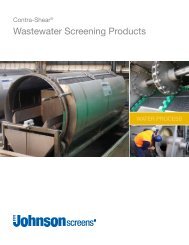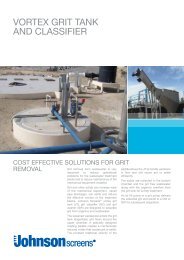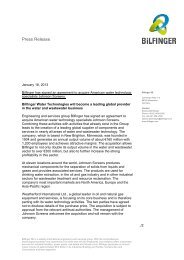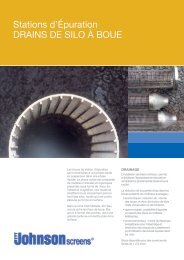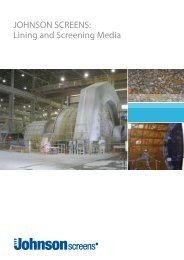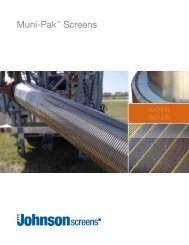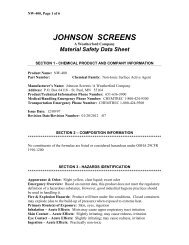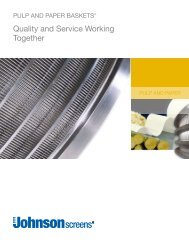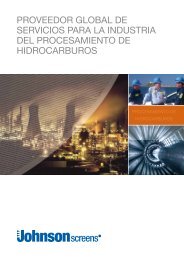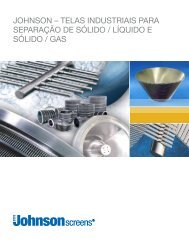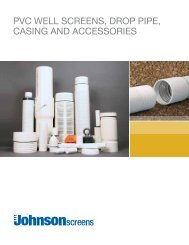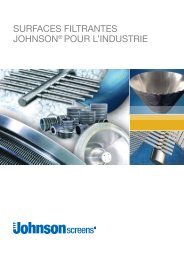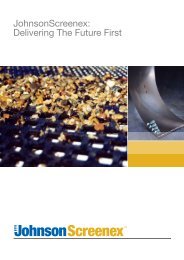Steel Brite II MSDS Sheet.pdf - Johnson Screens
Steel Brite II MSDS Sheet.pdf - Johnson Screens
Steel Brite II MSDS Sheet.pdf - Johnson Screens
You also want an ePaper? Increase the reach of your titles
YUMPU automatically turns print PDFs into web optimized ePapers that Google loves.
<strong>Steel</strong> <strong>Brite</strong> <strong>II</strong>, Page 1 of 7JOHNSON SCREENSA Weatherford CompanyMaterial Safety Data <strong>Sheet</strong>SECTION 1 - CHEMICAL PRODUCT AND COMPANY INFORMATIONProduct Name: <strong>Steel</strong> <strong>Brite</strong> <strong>II</strong>Part Number:Chemical Family: Mineral and organic acid plus dispersant and inhibitorManufacturer’s Name: <strong>Johnson</strong> <strong>Screens</strong> / A Weatherford CompanyAddress: P.O. Box 64118 – St. Paul, MN 55164Product/Technical Information Phone Number: 651-636-3900Medical/Handling Emergency Phone Number: CHEMTREC 1-800-424-9300Transportation Emergency Phone Number: CHEMTREC 1-800-424-9300Issue Date: 03-30-04Revision Date/Revision Number: 01/20/2012 / 06SECTION 2 – COMPOSITION INFORMATION************************************************************************% by WeightPhosphoric Acid Less than 20% Food GradeOrthophosphoric Acid(CAS # 7664-38-2)SECTION 3 - HAZARDS IDENTIFICATION************************************************************************Appearance & Odor: Colorless to lightly colored liquid; nil odorEmergency Overview: Overexposure may aggravate disorders of the skin / respiratorysystemFire & Explosion Hazards: None currently knownPrimary Route(s) of Exposure: Skin, eyes, digestive tract, respiratory systemInhalation – Acute Effects: May cause irritation / coughingSkin Contact – Acute Effects: May cause severe irritation; prolonged or repeated skincontact may cause burns, irreversible damageEye Contact – Acute Effects: May cause severe irritation / burns; prolonged or repeatedeye contact may cause irreversible damage or blindnessIngestion – Acute Effects: May cause irritation, burns, pain, nausea, vomiting, shocksymptoms (rapid pulse, sweating, collapse)
<strong>Steel</strong> <strong>Brite</strong> <strong>II</strong>, Page 2 of 7SECTION 4 - FIRST AID MEASURES************************************************************************Inhalation First Aid: Remove affected person from area to fresh air and provide oxygenif breathing is difficult. Give artificial respiration ONLY if breathing has stopped andgive CPR ONLY if there is no breathing and no pulse. Obtain medical attention.Skin Contact First Aid: Immediately remove clothing from affected area and wash skinfor 15 minutes with flowing water and soap. Clothing should be discarded or washedbefore reuse. Obtain medical assistance if irritation develops.Eye Contact First Aid: Immediately irrigate eyes with flowing water continuously for15 minutes while holding eyes open. Contacts should be removed before or duringflushing. Obtain medical attention immediately.Ingestion First Aid: If victim is alert and not convulsing, rinse mouth with water andgive plenty of water to drink. If spontaneous vomiting occurs, have affected person leanforward with head down to avoid breathing in of vomitus. Rinse mouth again and givemore water to drink. Obtain medical attention.Medical Conditions Aggravated: Persons with pre-existing skin disorders or eyeproblems, or impaired respiratory function may be more susceptible to the effects of thesubstance.Note to Physician: May give oxygen if breathing difficulty following exposure.Observe for possible delayed reactions.SECTION 5 - FIRE FIGHTING MEASURES************************************************************************Flash Point/Method: N/AAuto Ignition Temperature:Upper/Lower Explosion Limits: Not determinedExtinguishing Media: Chemical type foam, CO 2 (Carbon Dioxide), dry chemical, waterfogFire Fighting Procedures: Not considered a fire hazardFire & Explosion Hazards: Is not flammable, however the following can occur duringa fire: phosphorus oxides and/or phosphine from thermal decomposition and hydrogenfrom reactive metals.Hazardous Products of Decomposition and/or Combustion: Oxides of phosphorusNFPA Ratings:HEALTH FLAMMABILITY REACTIVITY OTHER2 0 00 = Insignificant 1 = Slight 2 = Moderate 3 = High 4 = Extreme
<strong>Steel</strong> <strong>Brite</strong> <strong>II</strong>, Page 3 of 7SECTION 6 – ACCIDENTAL RELEASE MEASURES************************************************************************Small spill: neutralize acid spill with alkali such as soda ash, sodium bicarbonate,limestone or lime. Absorb material with an inert material such as sand, vermiculite,diatomaceous earth or other absorbent material and place in chemical waste container tobe disposed at an appropriate waste disposal facility according to current applicable lawsand regulations and product characteristics at time of disposal. Adequate ventilation isrequired for soda ash due to the release of carbon dioxide gas. No smoking in spill area.Large spill: contain with dikes and transfer the material to appropriate containers forreclamation or disposal. Absorb remaining spill with an inert material such as sand,vermiculite or other absorbent material and place in chemical waste container to bedisposed at an appropriate waste disposal facility according to current applicable lawsand regulations and product characteristics at time of disposal. Neutralize residue withalkali such as soda ash, sodium bicarbonate, limestone or lime. Adequate ventilation isrequired for soda ash due to the release of carbon dioxide gas. No smoking in spill area.Release Notes: If spill could potentially enter any waterway, including intermittent drycreeks, contact the local authorities. If in the U.S., contact the US COAST GUARDNATIONAL RESPONSE CENTER toll free number 800-424-8802. In case of accidentor road spill notify: CHEMTREC in USA at 800-424-9300; CANUTEC in Canada at613-996-6666; CHEMTREC in other countries at (International code)+1-703-527-3887.Comments: See Section 13 for disposal information and Section 15 for regulatoryrequirements. Large and small spills may have a broad definition depending on the user’shandling system. Therefore, the spill category must be defined at the point of release bytechnically qualified personnel.SECTION 7 – HANDLING AND STORAGE************************************************************************Handling: For industrial use only. Some heat is generated upon dilution with water.When diluting, add product slowly to water with agitation. Never add water to the acid assome splashing could result. Always add acid to water. ATTENTION: This containerhazardous when emptied. Since emptied container contains product residues (vapor orliquid), all labeled hazard precautions must be observed.Storage: Keep container closed when not in use. Keep out of reach of children.General Comments: Wear protective equipment when handling. Use only withadequate ventilation. Wash thoroughly after handling. Do not breathe vapor, mist, ordust. Do not get in eyes, on skin, or clothing. Do not swallow.
<strong>Steel</strong> <strong>Brite</strong> <strong>II</strong>, Page 4 of 7SECTION 8 – PERSONAL PROTECTION/EXPOSURE CONTROL************************************************************************Respiratory Protection: If exposure limits are exceeded, or if exposure may occur, usea NIOSH/MSHA respirator approved for your conditions of exposure. Refer to the mostrecent NIOSH publications concerning chemical hazards, or consult your safetyequipment supplier. Respiratory protection programs must be in compliance with OSHArequirements in 29 CFR 1910.134. For emergencies, a NIOSH/MSHA approved positivepressure breathing apparatus should be readily available.Skin Protection: Acid proof gloves; clean, body covering clothing; rubber apron; rubberbootsEye Protection: Chemical goggles or faceshield (ANSI Z87.1 or approved equivalent).Always wear eye protection when working with chemicals. Do not wear contact lenseswhen working with chemicals.Ventilation Protection: Adequate ventilation is required to minimize exposure or tomaintain exposure levels below OSHA/ACGIH requirements. Mechanical generalventilation is usually adequate. Local mechanical ventilation may be required.Other Protection: Safety shower, eye wash fountain, and washing facilities should bereadily available. In case of emergency or when dusting, misting, or splashing mayoccur, wear respiratory protection, eye protection, gloves, helmet, boots, and completeprotective body covering.Exposure Limits:OSHA ACGIH NIOSH SUPPLIERTWA/TLV (ppm) TWA/TLV (ppm) None AEL=20 mg/m3 – 8 & 12 hrs TWA0.25 0.25SECTION 9 – PHYSICAL AND CHEMICAL PROPERTIES************************************************************************Appearance & Odor: Colorless to lightly colored liquid, no odorVapor Pressure: 5.700 @ 68 o F. Vapor Density (Air=1): Not determinedBoiling Point: 245 o F.Solubility in Water: CompleteSpecific Gravity: 1.34 @ 70 o F. pH: aqueous approx. 1.000 to 2.000Volatile Percentage: Not determined Auto Ignition Temperature: NoneFlash Point/method: N/AUpper/Lower Explosion Limits: NoneOther:
<strong>Steel</strong> <strong>Brite</strong> <strong>II</strong>, Page 5 of 7SECTION 10 - STABILITY AND REACTIVITY************************************************************************Stability: Stable under normal conditions of storage and useIncompatibilities: Inorganic bases, metals/metal blends; contact with some metals cangenerate explosive hydrogen gasPolymerization: Will not occurDecomposition: Oxides of phosphorus and/or phosphine from thermal decompositionand hydrogen gas from reaction with metalsConditions to Avoid: High temperature or contact with strong bases or oxidizing agentsSECTION 11 - TOXICOLOGICAL INFORMATION************************************************************************Inhalation – Acute: LC 50 (guinea pig, mouse, rat, rabbit): 61-1,689 mg/m 3 (acutevalues for 75-85% acid)Inhalation – Chronic: Not establishedSkin Contact – Acute: LD 50 (rabbit): >1,260 to > 3,160 mg/kg (acute values for 75-85%acid)Skin Contact – Chronic: Skin irritationEye Contact – Acute:Ingestion – Acute: Oral LD 50 (rat): >5000 mg/kgIngestion – Chronic:Carcinogenicity/Mutagenicity: No components present in excess of 0.1% by weight arelisted as carcinogens by IARC, NTP, or OSHAReproductive Effects: 375 mg/kg bw did not affect offspring growth in ratsNeurotoxicity: None knownOther Effects: In vitro bacterial genetic toxicity negativeTarget Organs: Overexposure may cause damage to all body tissuesSECTION 12 – ECOLOGICAL INFORMATION************************************************************************Ecotoxicity: acute toxicity to fish: 96 hour LC 50 : 3.0 – 3.5 mg/L (15 to 17.5 mg/L ofconcentrated product)Acute toxicity to Daphnia: survival rate depends on pHEnvironmental Fate: phosphoric acid undergoes ionic dissociation in water.Toxicity: Moderately toxic to aquatic organisms as defined by USEPA (exhibited byconcentrated phosphoric acid)Degradation Products: while acidity of this material is readily reduced in natural waters,the resulting phosphate may persist indefinitely or incorporate into biological systems.SECTION 13 – DISPOSAL CONSIDERATIONS************************************************************************Material that cannot be used or chemically reprocessed and empty containers should bedisposed of in accordance with all applicable regulations. Product containers should bethoroughly emptied before disposal. Generators of waste material are required to
<strong>Steel</strong> <strong>Brite</strong> <strong>II</strong>, Page 6 of 7evaluate all waste for compliance with RCRA and any local disposal procedures andregulations. NOTE: State and local regulations may be more stringent than federalregulations.DOT Shipping Description:SECTION 14 – TRANSPORTATION INFORMATIONProper Shipping Name: Commercial commodity containing less than 20%phosphoric acidHazard Class:Label Requirements:Reportable Quantity:8, UN1805, PG <strong>II</strong>I, Non hazardous as ORM-D(49CFR.173.154)CORROSIVE required on larger containers; not requiredif shipped in containers of 4 liters or less with totalpackage weight
<strong>Steel</strong> <strong>Brite</strong> <strong>II</strong>, Page 7 of 7TSCA Inventory Status: Chemical components listed on TSCA Inventory.California Proposition 65: This product does not contain any chemicals currently on theCalifornia list of known carcinogens and reproductive toxins.Canadian WHMIS Classification: This product does not contain any hazardous materialsunder CPR and this <strong>MSDS</strong> discloses all information elements required by the CPR.SECTION 16 – OTHER INFORMATIONDisclaimer: The information contained herein is based on data considered accurate.However, no warranty is expressed or implied regarding the accuracy of this data or theresults to be obtained from the user thereof. It is the buyer’s responsibility to ensure thatits activities comply with federal, state, provincial and local laws.



